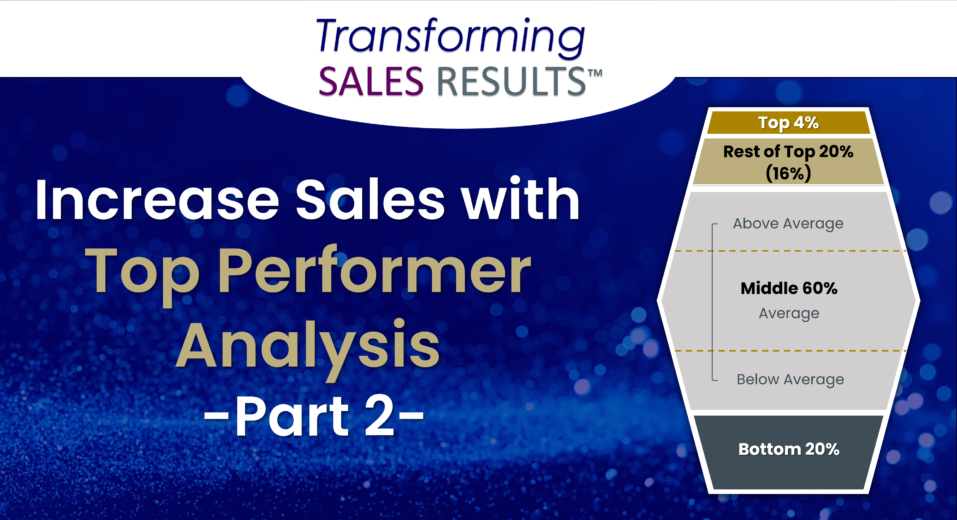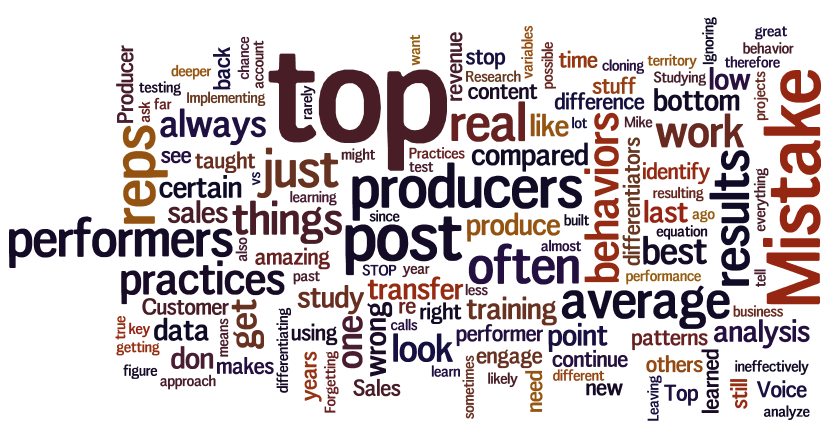How to Increase Sales with Top Performer Analysis – Part 2

 In part one of this series, I discussed the misnomer inherent in the term “best practices” and recommended “top performer practices” instead. I also pinpointed the reason for the bad reputation, since poorly executed best practices projects often fail to produce tangible results. In the projects I’ve run over the past 25+ years, I’ve learned there are a few differentiating factors in making Top Performer Practices research work for you. I ended the last post with the most common mistakes and said I’d share how to correct them, to get your “Top Performer Practices” initiative right and get the results you need.
In part one of this series, I discussed the misnomer inherent in the term “best practices” and recommended “top performer practices” instead. I also pinpointed the reason for the bad reputation, since poorly executed best practices projects often fail to produce tangible results. In the projects I’ve run over the past 25+ years, I’ve learned there are a few differentiating factors in making Top Performer Practices research work for you. I ended the last post with the most common mistakes and said I’d share how to correct them, to get your “Top Performer Practices” initiative right and get the results you need.
- Mistake 1: Studying the wrong “top reps” and therefore, cloning the wrong behaviors
- Mistake 2: Ignoring differentiators, compared to average and low producers
- Mistake 3: Leaving the Voice of the Customer out of the equation
- Mistake 4: Forgetting “what to STOP doing”
- Mistake 5: Implementing the resulting training ineffectively
Mistake 1: Studying the Wrong “Top Reps”
This sounds obvious but it’s trickier than it seems. The key is doing your own analysis to identify the true top performers, the average producers, and those in the bottom two deciles. Then, you study all the groups, and look for patterns. (See this post for more on this topic.)
I stopped asking for leaders to identify study candidates years ago. Very often, companies just count revenue and hand you a ranking. While their “top reps” do have the most revenue, you have to look deeper, to weed out those who are top reps by circumstance. What’s that mean? It means they inherited a great territory from someone, were handed an RFP for an elephant in their region, or have been around forever and have adopted enough orphan accounts that they didn’t really earn, but that produce business for them anyway. Compare this to the rep who has a smaller revenue number, but who has built her territory from the ground up and grown it by 40% a year for three years running. Who do YOU want to study and clone?
Choosing your metric mix, determining performer categories, and analyzing what makes the top different is where the magic is. I wrote another post awhile back on sales performance analysis, which you can find right here, if you’d like to dig deeper.
Mistake 2: Ignoring Comparisons and Differentiators
I mentioned this already, but the key is finding the differentiating behaviors between the top performers compared to the average and low ones.
Everyone thinks to study top performers, but rarely do I see them compared to others. For example, if a top performer does a task at a certain frequency, to a certain level of mastery, that’s just a data point. If you learn that average performers do it much more often but far less well, that might mean something different than if average performers rarely do it at all. I’m relatively analytical, but I almost always engage a real statistician to analyze the results with me and to do the geeky things (data crunching and statistical analysis) that matter.
As you look at the data, sometimes things really do jump out at you. Other times, it’s less clear. By using ratings, rankings, survey data, and turning everything possible into numerical data, you can do things like the following, to find links between behaviors and results:
- The Chi-square test, which is intended to test how likely it is that an observed distribution is due to chance.
- Multivariate regression analysis to determine the relationship between multiple variables, to see what might be causing the variation.
- Predictive analytics, to analyze the likelihood of getting a result based on certain variables (doing certain things that top performers do but others don’t, etc.) or probability testing or hypothesis testing, and so on.
While there’s more here than I can write in a blog post, the bottom line is this: spend time comparing the top vs. the middle vs. the bottom, and looks for what makes a difference (patterns are best), across body of people (not just the amazing outliers). It’s far more effective than just studying the top and will likely produce the replicable, repeatable behaviors than can be taught to us mere mortals. (Acknowledging, of course, that the top 4% often do amazing things that the rest of us can’t easily pull off. Often, their behavior is just not scalable.)
Mistake 3: Leaving Out the Voice of the Customer
The last time I did this work, my employer didn’t want me to include the Voice of the Customer. I was stunned, but couldn’t get past the roadblock. At one point, after the Board balked at my Top Performer Analysis approach, they hired an outside firm (happened to be ES Research, owned and run by Dave Stein) to independently review my work to help them decide if we should continue. ESR validated my approach, and then went on to add that we should insert the customer into the process. I was vindicated, but still couldn’t sell it. Go figure.
Your customers tell you amazing things if you ask, listen, dig deep, and engage in an authentic dialogue with them. Win-loss analysis is also especially helpful. Asking what makes a real difference to them with their sales reps, and digging into the details, can be enlightening. At one service company, which was built on repeat business, we heard consistently from clients that a long lag between voicemails and return calls was an industry issue and perception of our reps and our competitors’ reps. We became fanatical about answering calls or returning them as quickly as possible. A year later, we learned that this made a difference in both new account acquisition and current account growth.
Mistake 4: Forgetting “What to STOP Doing”
This harkens back to the previous point about differentiators, but is often more neglected than comparisons. As you figure out what average producers should continue or start doing, to perform more like a top performer, don’t forget to look for what to stop. This “avoid the worst practices” mentality can be very productive. It’s like having one foot on a gas pedal and the other on the brake, at the same time. Release the brake (stop doing what doesn’t work or hampers results), and you’ll leap forward. Very often, you can identify these practices by what the low producers do a lot of, that top producers do not. This is not always true, since as you progress through levels of performance, sometimes you need to develop new behaviors (as Marshall Goldsmith says, “What got you here won’t get you there.”) So, this one is not always clear-cut from that perspective, but even anecdotally, top performers can usually tell you what others should just stop doing, to improve their results. I always look for this stuff, and always ask top producers about it specifically.
Mistake 5: Implementing the Resulting Training Ineffectively
I probably can’t say this any better than I did in Dave Stein’s gracious interview with me, back in 2012. This can get detailed and complicated, too, but the real nugget is this:
- Content: What you’re teaching should come from the hypotheses, analyses, and data-crunching that I’ve shared in this post. The content needs to be the right stuff that will produce results on the front-lines. If not, don’t bother even starting. It’s just an exercise in futility at that point.
- Delivery: This goes all the way back to the instructional design quality and includes how the content is delivered. If you’re not creating real training systems – with prework, blending learning, confirmed knowledge transfer and prep before vILT (virtual instructor-led training) or ILT programs, which should focus almost entirely on skill practice, feedback, and forming new behavior patterns, while in the class – you are not going to get the best possible results.
- Transfer: Next, if you’re not purposefully orchestrating transfer, you are missing the boat. The best content, taught intelligently, is still often left on the classroom floor, without solid transfer plans. Broad and Newstrom’s classic “Before / During / After” method for all involved stakeholders, still works.
Bottomline? Get focused on transfer, learn everything you can, engage your sales managers in reinforcement and coaching, and you have a chance of getting your training used in the real world. And on managers… they need to know how to diagnose whether their reps are using what was taught, to what degree, and how to coach to close those gaps. “Imperative to success” is not too strong a phrase. If you want real performance improvement, put your sales managers first, and start with them.
For more on the Sales Training System, see: this post and this one.
I’ll end with his reminder that all this work can be for naught, if you don’t communicate throughout the process inside your organization and share the results.
Well, that’s it for this post. I hope it provided some real value for you. Thanks for reading, be safe out there, and by all means… let’s continue to elevate our sales profession
Mike
Follow my work and connect
- SPARXiQ Blog: https://sparxiq.com/author/mikekunkle
- The Building Blocks of Sales Enablement Book: https://bit.ly/BBofSE
- Distribution Strategy Group Blog: https://distributionstrategy.com/author/mike-kunkle/
- Sales Effectiveness Straight Talk Webinars: https://bit.ly/MikeKunkle-OnDemand (60 Free Recorded Webinars)
- LinkedIn Articles: http://bit.ly/MK-LinkedInArticles
- LinkedIn Profile: https://www.linkedin.com/in/mikekunkle
- Twitter: https://twitter.com/mike_kunkle
About Mike
Mike Kunkle is a recognized expert on sales training, sales effectiveness, and sales enablement. He’s spent over 27 years helping companies drive dramatic revenue growth through best-in-class training strategies and proven-effective sales transformation systems – and he’s delivered impressive results for both employers and clients. Mike is the founder of Transforming Sales Results, LLC and works as the Vice President of Sales Effectiveness Services for SPARXiQ, where he designs sales training, delivers workshops, and helps clients improve sales results through a variety of sales effectiveness services. Mike collaborated with Doug Wyatt to develop SPARXiQ’s Modern Sales Foundations™ curriculum and also authored the SPARXiQ’s Sales Coaching Excellence™ course. His book, The Building Blocks of Sales Enablement, is available on Amazon.

